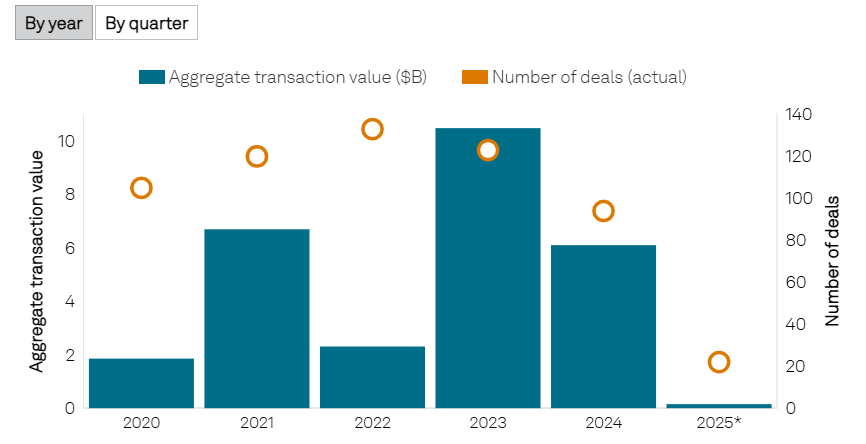New Money Flows: How Alternative Financing is Reshaping Mining Capital Markets

Alternative financing transforms mining: crypto, private equity, and tech investors deploy billions into critical minerals projects, reshaping traditional capital markets.
- The mining industry is experiencing a fundamental shift from traditional equity markets to alternative financing sources, with cryptocurrency wealth, private equity expansion, and technology sector investment creating unprecedented capital flows that are reshaping how mining companies approach development strategies, risk management, and investor relations.
- Private equity investment in mining is poised for significant growth driven by global demand for critical minerals essential to energy transition demonstrating the sector's expanding role in financing copper, lithium, and silver projects.
- Tether's acquisition of a 37.8% stake in Elemental Altus Royalties Corp exemplifies how digital asset companies are deploying substantial capital reserves into traditional mining operations as a potentially transformative force that can execute transactions with unprecedented speed compared to traditional mining finance processes.
- Mining investments from the technology sector, including Bill Gates and Jeff Bezos as investors, represents a significant shift in how technology companies view resource extraction, with AI-driven exploration techniques validating the effectiveness of machine-learning approaches in mineral discovery and development.
- Alternative financing sources bring distinct risk profiles requiring careful attention to capital allocation discipline, project timeline alignment with fund lifecycles, and strategic communication with investor groups that may lack deep mining sector expertise, while the convergence of government policy support, technological advancement, and capital availability suggests continued acceleration in alternative financing adoption for critical minerals projects.
New Faces of Mining Capital Fundings
The convergence of cryptocurrency wealth, private equity expansion, and technology sector investment is creating unprecedented capital flows into mining operations. These alternative financing mechanisms are not merely supplementing traditional funding sources but are beginning to reshape how mining companies approach development strategies, risk management, and investor relations.
Private Equity Expansion
The mining sector is poised for significant growth in private equity investment as global demand for critical minerals essential to energy transition, such as silver, copper and lithium, continues to accelerate according to S&P Global analytics. The report highlights a pressing supply-demand imbalance, noting that global production of most battery metals has been declining due to weak pricing conditions, creating an urgent need for new capital investments to expand supply capacity.

Source: S&P Global PE Deals in Metals, Mining Set to Pick Up as Critical Mineral Demand Rises
In 2025, Chilean miner Pucobre obtained a $375million loan from a syndicate of international banks for its El Espino copper-gold project in Coquimbo region. The agreement was signed through subsidiary El Espino SpA, which is managed by US private equity firm RCF Management. Total investment in the project amounts to $700 million for annual production of 26,000t of copper and 13,000oz of gold for 18 years. Notably, Resource Capital Funds holds a diverse portfolio into critical minerals, metals, and mining including Alkane Resources and Bravo Mining, towards continued advancements in energy, security, technology, and industrialization across the globe.
The expansion of private equity into mining reflects broader recognition that critical minerals extraction is essential to multiple industrial transitions. As noted in a Norton Rose Fulbright's analysis,
"The energy transition and the long-term secular trends which go along with it stretch across the battery, automotive, manufacturing, transportation industries, among others. As investors seek to deploy capital across these industries to 'invest with the trend', they quickly realise what has been apparent to those in the mining industry for a long time -- there is no transition without access to (and, therefore, the mining of) critical minerals." - S. Ward Atterbury, Norton Rose Fulbright Global Head of Private Equity
The International Renewable Energy Agency estimates that over $35 trillion of capital investment needs to be deployed prior to 2030 to support a successful global energy transition. The limited life of private equity funds creates additional complexity in finding investable mining assets in supportive jurisdictions that provide sufficient risk-adjusted returns within typical fund lifespans. These structural challenges have historically kept generalist investors on the sidelines but are being addressed through innovative fund structures and government support mechanisms.
Cryptocurrency Capital Enters Mining Operations
The entry of cryptocurrency-derived capital into mining represents one of the most significant developments in alternative financing. Tether's acquisition of a 37.8% stake in Elemental Altus Royalties Corp demonstrates how digital asset companies are deploying substantial capital reserves into traditional mining operations.
Tether's financial capacity far exceeds typical mining industry participants, with the company holding over $100 billion in deposits invested in U.S. treasuries yielding 4-5%. Crucially, Tether does not pay interest on these deposits, as users exchange U.S. dollars for USDT stable coins used in cryptocurrency transactions. This structure generates over $5 billion annually in cash flow for the company.
Derek Macpherson, Executive Chair of Olive Resource Capital, provided context on the scale of this development:
"Franco Nevada has a revenue of $1 billion, so just think about context here - it's five times larger an entity."
This financial capacity positions Tether as a potentially transformative force in mining sector capital allocation.
The transaction itself demonstrates the speed at which cryptocurrency capital can be deployed. According to Macpherson:
"The first conversation happened in May, so from May till the middle of June, Tether was able to move very quickly and execute on moving two very large blocks of stock."
This execution timeline contrasts sharply with traditional mining finance processes, which often require months or years of due diligence and regulatory approval.
The market response to Tether's investment has been measured but positive. Following the announcement, Elemental Altus's stock price increased from $1.55 to approximately $1.80, representing a 16% gain. More significantly, the investment has generated inquiries from hedge funds and other investors not traditionally focused on the mining royalty space, suggesting broader interest in cryptocurrency-backed mining investments.
Sam Pelaez, President and CEO of Olive Resource Capital, emphasized the broader implications:
"We frequently complain about the lack of new liquidity and capital moving into the space and overnight, out of nowhere, you have this group that has immense liquidity."
This development addresses a persistent challenge in the mining industry, where traditional capital sources have been constrained and new investor interest has been limited.
Technology Sector Invests in Metals and Mining
Silicon Valley's entry into mining investment represents a significant shift in how technology companies view resource extraction. KoBold Metals' $537 million equity funding, with investors including Bill Gates' Breakthrough Energy Ventures and Jeff Bezos, demonstrates the scale of technology sector interest in mining operations. Founded in 2018, KoBold operates by integrating machine-learning algorithms with geological data to enhance the accuracy and efficiency of mineral discovery.
The company's proprietary platforms, TerraShed and Machine Prospector, analyze historical and current geological data to identify and prioritize drilling targets. This technological approach aims to reduce the time and costs associated with traditional mineral exploration. KoBold CEO Kurt House articulated the company's strategic positioning:
"KoBold's mission is to expand and diversify the global supply of critical resources essential for prosperity, energy technology, AI, and security."
KoBold's recent discoveries validate the potential of AI-driven exploration. In 2024, the company announced the discovery of a significant copper deposit at its Mingomba project in Zambia, considered one of the largest high-grade copper discoveries in recent years. This success demonstrates the effectiveness of machine-learning techniques in mineral exploration and provides validation for technology sector investment in mining operations.
With this, Northisle Copper & Gold CEO Sam Lee identified the broader opportunity for technology sector involvement:
"There is so much untapped disruptive capital in areas that we would never explore like Silicon Valley for instance."
Lee observed increasing interest from generalist investors, with over 15 institutions attending a recent Montreal marketing event, half of which were generalist rather than mining-focused funds.
Risk Management and Execution Considerations
Alternative financing sources bring distinct risk profiles and execution requirements compared to traditional mining finance. Cryptocurrency-derived capital, while offering substantial liquidity, introduces concerns about capital allocation discipline and long-term strategic alignment.
Macpherson outlined potential risks associated with cryptocurrency investment:
"The place where we lose is that all of a sudden, because they're awash with capital. We get an undisciplined approach to new acquisitions. They overpay, they get out of it."
However, Tether's retention of existing management at Elemental Altus and early indications of disciplined approach provide some mitigation of these concerns.
Private equity investment requires careful alignment of project timelines with fund lifecycles. The capital requirements for mining projects often exceed typical private equity investment horizons, requiring innovative structuring to accommodate both investor requirements and project development needs.
Technology sector investment brings additional considerations around intellectual property integration, data sharing protocols, and operational technology implementation. The success of AI-driven exploration companies like KoBold depends on maintaining proprietary technological advantages while scaling operations across multiple jurisdictions.
Future Outlook and Industry Evolution
The influx of alternative capital is beginning to reshape mining sector dynamics. Traditional mining finance relied heavily on equity markets, debt facilities, and specialized mining funds. The entry of cryptocurrency capital, private equity, and technology sector investment is creating new competitive dynamics and valuation frameworks.
The philosophical alignment between cryptocurrency investors and precious metals investors creates potential for broader crossover participation. Macpherson noted this convergence:
"There's a lot of crossover between the gold bugs and the Bitcoin bugs. Right now they're both sort of anti-fiat currency groups."
This common ground could facilitate broader cryptocurrency investor participation in gold and mining investments.
Market Implications
The fundings comes amid growing global competition for control over critical minerals supply chains. Currently, China dominates the processing and supply of materials like lithium and copper, both essential for battery production and renewable energy storage. The U.S. government has responded by introducing policies to counterbalance China's market share, including tariffs and incentives for domestic critical minerals production.
The success of early alternative financing initiatives will likely encourage additional capital deployment from similar sources. KoBold's successful copper discovery and Tether's disciplined approach to mining investment provide validation for other alternative capital sources to enter the mining sector.
The mining industry's capital requirements for supporting global energy transition exceed traditional financing capacity, ensuring continued need for alternative capital sources. In his analysis on Private Capital in Mining, Ward Atterbury concluded:
"The accelerated deployment of private capital from sector specialists and generalists alike will continue to be critical in helping to facilitate the global energy transition."
Conclusion and Key Takeaway
The mining industry's shift toward alternative financing represents a fundamental transformation in how projects secure development capital. Cryptocurrency-derived funds, private equity expansion, and technology sector investment are creating new pathways for project financing that complement and increasingly replace traditional equity markets.
This transformation offers significant opportunities for mining companies that can effectively navigate the requirements and expectations of alternative capital sources. The scale of available capital from these sources far exceeds traditional mining finance capacity, potentially accelerating project development timelines and expanding the universe of viable mining investments.
However, success in accessing alternative capital requires careful attention to risk management, strategic alignment, and communication with investor groups that may lack deep mining sector expertise. Companies that successfully adapt to these requirements are likely to gain significant competitive advantages in accessing development capital and accelerating project timelines.
The convergence of policy support, technological advancement, and capital availability suggests that alternative financing will continue to play an increasingly important role in mining sector development, particularly for critical minerals projects essential to global energy transition and technology infrastructure development.
Analyst's Notes




Subscribe to Our Channel
Stay Informed




































